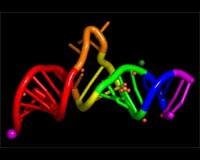| . |  |
. |
Washington DC (SPX) May 26, 2011 Imagine shrinking to the size of a doll in your sleep. When you wake up, will you perceive yourself as tiny or the world as being populated by giants? Researchers at Karolinska Institutet in Sweden may have found the answer. According to the textbooks, our perception of size and distance is a product of how the brain interprets different visual cues, such as the size of an object on the retina and its movement across the visual field. Some researchers have claimed that our bodies also influence our perception of the world, so that the taller you are, the shorter distances appear to be. However, there has been no way of testing this hypothesis experimentally - until now. Henrik Ehrsson and his colleagues at Karolinska Institutet have already managed to create the illusion of body-swapping with other people or mannequins(Now they have used the same techniques to create the illusion of having a very small doll-sized body or a very large, 13-foot tall body. Their results, published in the online open access journal PLoS ONE, show for the first time that the size of our bodies has a profound effect on how we perceive the space around us. "Tiny bodies perceive the world as huge, and vice versa," says study leader Henrik Ehrsson. The altered perception of space was assessed by having subjects estimate the size of different blocks and then walk over to the blocks with their eyes shut. The illusion of having a small body caused an overestimation of size and distance, an effect that was reversed for large bodies. One strategy that the brain uses to judge size is through comparison - if a person stands beside a tree it computes the size of both. However, the sensed own body seems to serve as a fundamental reference that affects this and other visual mechanisms. "Even though we know just how large people are, the illusion makes us perceive other people as giants; it's a very weird experience," says Dr Ehrsson, who also tried the experiment on himself. The study also shows that it is perfectly possible to create an illusion of body-swapping with extremely small or large artificial bodies; an effect that Dr Ehrsson believes has considerable potential practical applications. "It's possible, in theory, to produce an illusion of being a microscopic robot that can carry out operations in the human body, or a giant robot repairing a nuclear power plant after an accident," he says. Citation: van der Hoort B, Guterstam A, Ehrsson HH (2011) Being Barbie: The Size of One's Own Body Determines the Perceived Size of the World. PLoS ONE 6(5): e20195. doi:10.1371/journal.pone.0020195
Share This Article With Planet Earth
Related Links Public Library of Science All About Human Beings and How We Got To Be Here
 New level of genetic diversity in human RNA sequences uncovered
New level of genetic diversity in human RNA sequences uncoveredLos Angeles CA (SPX) May 26, 2011 A detailed comparison of DNA and RNA in human cells has uncovered a surprising number of cases where the corresponding sequences are not, as has long been assumed, identical. The RNA-DNA differences generate proteins that do not precisely match the genes that encode them. The finding, published May 19, 2011, in Science Express, suggests that unknown cellular processes are acting on RNA to ... read more |
|
| The content herein, unless otherwise known to be public domain, are Copyright 1995-2010 - SpaceDaily. AFP and UPI Wire Stories are copyright Agence France-Presse and United Press International. ESA Portal Reports are copyright European Space Agency. All NASA sourced material is public domain. Additional copyrights may apply in whole or part to other bona fide parties. Advertising does not imply endorsement,agreement or approval of any opinions, statements or information provided by SpaceDaily on any Web page published or hosted by SpaceDaily. Privacy Statement |